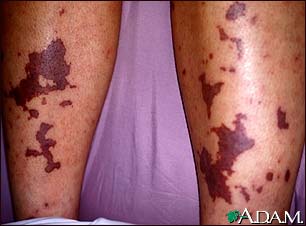Disseminated intravascular coagulation (DIC)

Disseminated intravascular coagulation (DIC) - a secondary COAGULATION disorder arising from an imbalance among the CLOTTING FACTORS in the BLOOD. DIC occurs as a result of a significant underlying health condition such as HIV/AIDS, overwhelming infections, or CANCER, and as a serious complication in PREGNANCY. DIC is a symptom rather than a condition. Indications of its presence include
- PETECHIAE (pinpoint hemorrhages), especially on the roof of the MOUTH (soft palate) and the lower legs
- ECCHYMOSIS (easy bruising)
- hemorrhage (easy bleeding)
- thrombosis (clot formations in the blood vessels, typically the veins)
The diagnostic path includes blood tests, especially fibrinogen and fibrin split products. Treatment for DIC targets the underlying cause, though may include measures such as BLOOD TRANSFUSION to arrest hemorrhaging or ANTICOAGULATION THERAPY when the condition manifests as thrombosis. The outlook, like the treatment, depends on the underlying cause.
See also PLATELET.